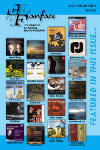Texte paru dans: / Appeared in:

Fanfare Magazine: 36:6 (07-08/2013)
Pour
s'abonner / Subscription information
Les abonnés à Fanfare Magazine ont accès aux archives du
magazine sur internet.
Subscribers to Fanfare Magazine have access to the archives of the magazine
on the net.
Aparté
041

Code-barres
/ Barcode : 3149028024227
Consultez toutes les évaluations recensées pour ce cd
~~~~ Reach all the evaluations located for this CD
Often we get thematic programs of early music that don’t fit the particulars when they’re examined up close. Not for the most part here, however. This isn’t simply a survey of orchestral music in the last half of the 17th century, but of works by composers whose music could be heard at the Viennese court of Emperor Leopold I. He was a ruler repeatedly described as believing few things better than listening to music, whether at chapel, in the extravagant diplomatic fetes he threw regularly, or the equestrian pageants he enjoyed that featured as many as 600 horses and 1,700 human participants (including 100 musicians). The virtuoso violinist-composers that came out of various Italian courts in the late 16th and early 17th centuries formed the musical models Leopold embraced. It’s therefore no surprise that three out of four composers on this album were virtuoso violinists whose music was directly or indirectly influenced by those same Italians.
The works are consequently of a kind. Four are early violin sonatas, the type that mix recitative passages, lyrical arias, and fast dance movements, each adhering to its own individual structure. A fifth, Walther’s Suite, amounts to the same thing. Only one is an outlier: Froberger’s famous Lament on the Very Sad Death of His Imperial Majesty, Ferdinand III for harpsichord, that partakes strongly of the style of contemporary French lutenists. But though far away from the musical range in which Leopold typically grazed, Froberger did dedicate a volume of music to him: a connection of sorts.
Ensemble Stravaganza is a French-Italian chamber group dedicated to 17th- and 18th-century music featuring one or two self-described “high-pitched instruments.” Its leaders are violinist Domtille Gilon and harpsichordist Thomas Soltani, heard here with continuo provided by viol da gamba, theorbo, and organ. The violin pieces are given lively, well-accented renditions, sensitive to the theatrical conception of each work, in a style moderately similar to that of Quicksilver on their Stile Moderno album (Acis APL72546). Like Mealy and Andrijeski, Gilon does much through varying tonal weight, and the discreet application of vibrato, mostly fast but occasionally slow. Her technique is excellent; so is Soltani’s, whose rendition of the Lament correctly interprets it according to style brisé, in a slow, very flexibly phrased manner. No information on his instrument is provided, though he uses what sounds like a temperament ordinaire tuning.
The engineering is another positive, close but clear, never covering violin or harpsichord in an aural haze. This is Ensemble Stravaganza’s first album. I hope it isn’t their last.
Cliquez l'un ou l'autre
bouton pour découvrir bien d'autres critiques de CD
Click either button for many other reviews


